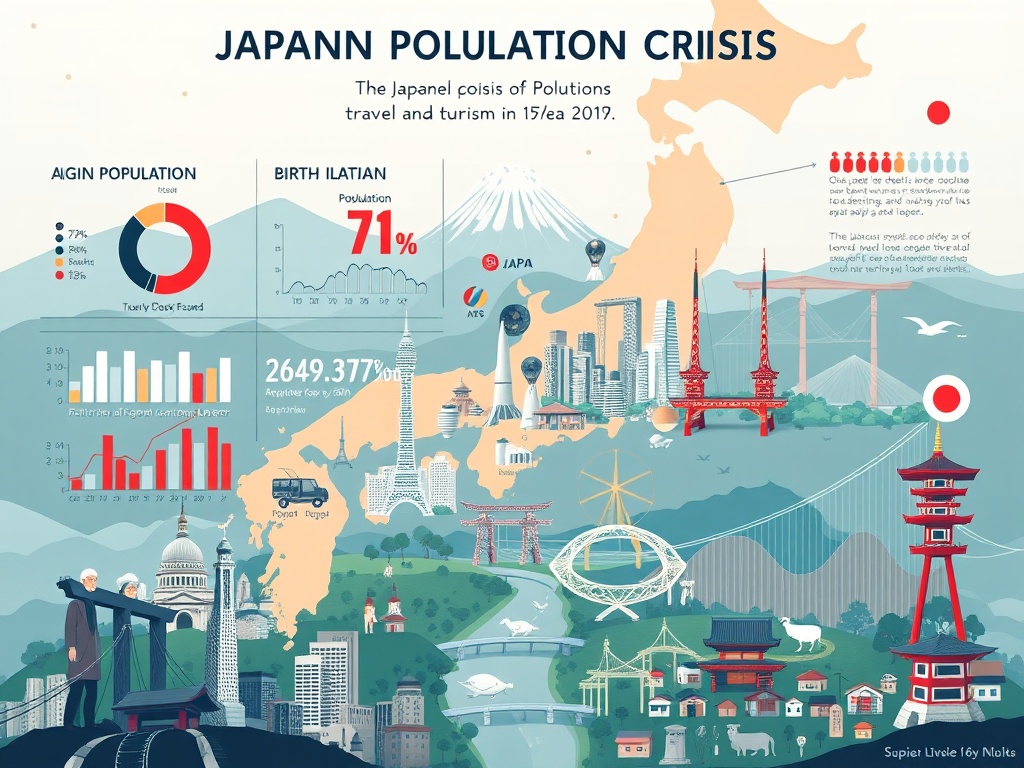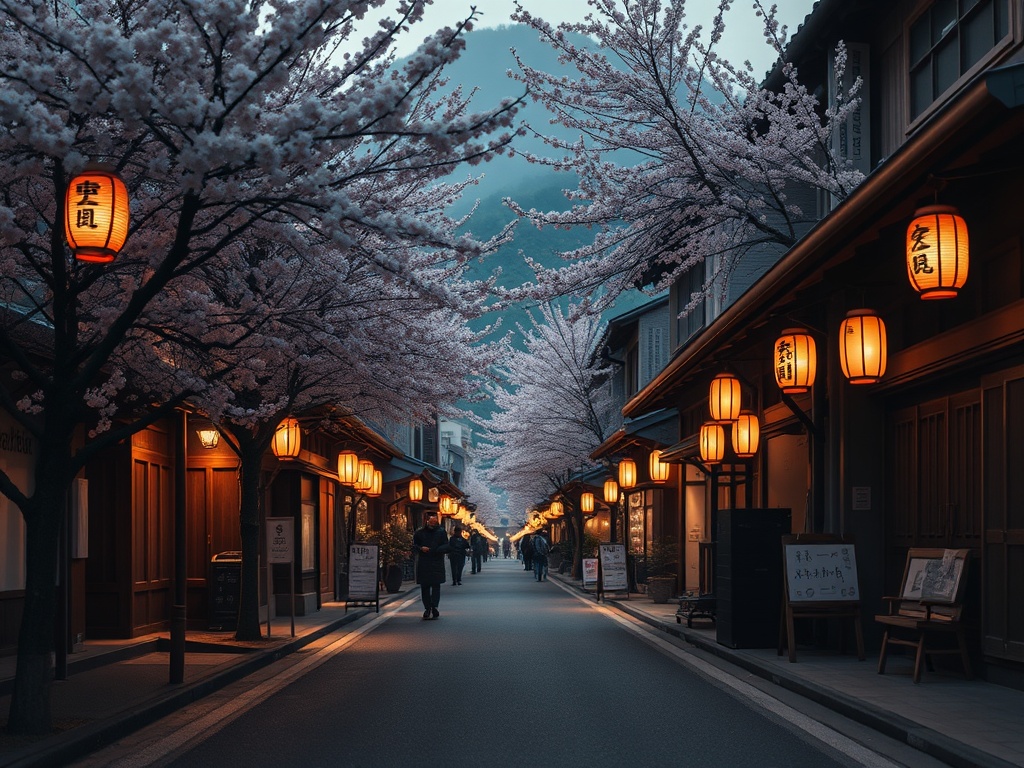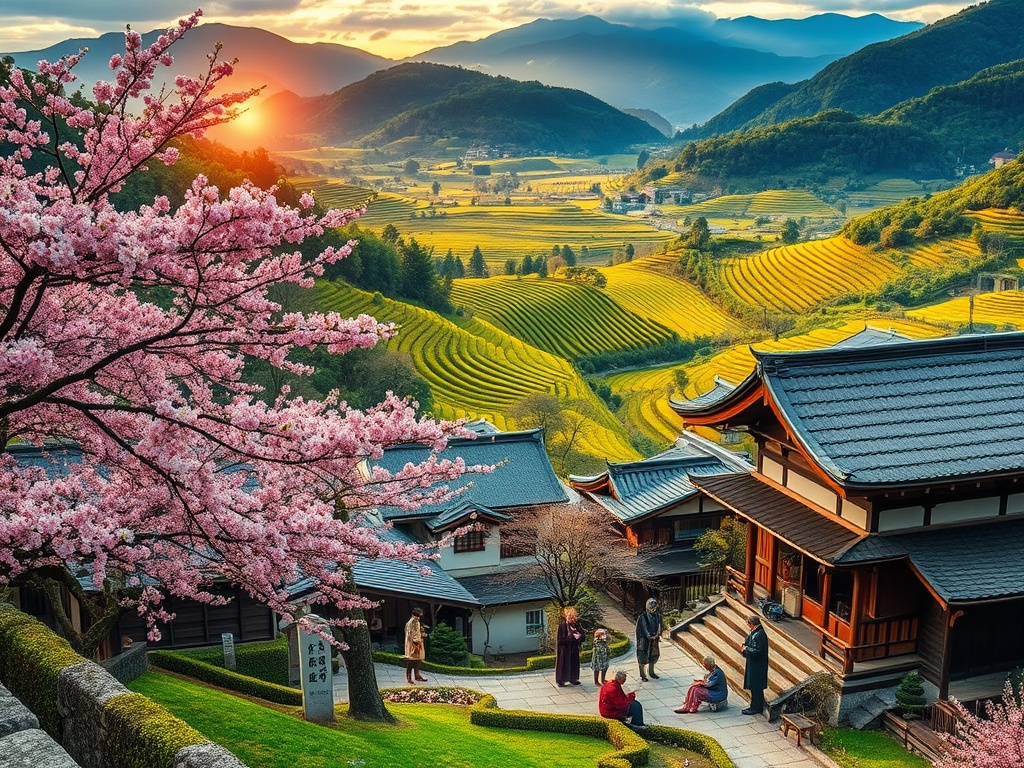The Shrinking Land of the Rising Sun: A New Era of Exploration
Win a Free Trip to Japan!
Experience cherry blossoms and ancient temples
Japan, known for its vibrant culture, technological advancements, and breathtaking landscapes, faces a paradoxical challenge: a declining population. However, this demographic shift offers a unique opportunity for travel enthusiasts to explore the cultural depths of Japan with fewer crowds and more authentic experiences. As the population shrinks, traditional towns and lesser-known destinations are becoming more accessible, inviting travelers to dive into the heart of Japan’s cultural heritage.
While Tokyo and Kyoto remain perennial favorites, the changing demographic landscape has opened the doors to regions that were once overshadowed. These hidden gems allow travelers to uncover the stories and traditions that have shaped Japan over centuries.
- Kanazawa: Often called ‘Little Kyoto’, this city offers well-preserved Edo-era districts, art museums, and stunning gardens.
- Tottori Sand Dunes: Experience Japan’s own desert and enjoy unique activities like sandboarding and camel rides.
- Nagasaki: A city with a complex history, offering poignant reminders of the past and a blend of international influences.
With fewer people competing for space, travelers can immerse themselves in authentic Japanese experiences. From staying in ryokans (traditional inns) to participating in tea ceremonies, the opportunities for cultural engagement are endless.
Consider these experiences that allow a deeper connection with Japan’s heritage:
| Experience | Description |
|---|---|
| Onsen (Hot Springs) | Relax in natural hot springs, a quintessential Japanese experience, often surrounded by stunning nature. |
| Ikebana (Flower Arranging) | Learn the art of flower arranging, a practice that emphasizes harmony, balance, and form. |
| Bonsai Workshops | Engage in the intricate art of cultivating miniature trees, a practice rooted in patience and precision. |
Where Have All the People Gone? Discovering Japan’s Silent Streets
Japan’s shrinking population is like an invisible hand reshaping the urban landscape, quietly turning once-bustling streets into serene pathways. This transformation is no cause for alarm but rather an invitation to explore Japan’s cities in a new light. As the number of inhabitants decreases, the pace of life slows down, offering a unique travel experience that allows visitors to savor the country’s rich history and culture without the usual hustle and bustle.
Strolling through Japan’s quieter streets, one can almost hear the whispers of history echoing off the walls of traditional wooden houses and ancient temples. In places like Takayama, known for its beautifully preserved Edo-period buildings, travelers can wander through narrow alleys, discovering artisanal shops and family-run businesses that have stood the test of time. The absence of large crowds means you can enjoy these sites at your own pace, often feeling as though you’ve stepped back in time.
Even in larger cities like Osaka and Nagoya, the population decline has created spaces for urban retreats. Parks and public spaces that were once crowded are now havens of peace where you can relax and admire Japan’s blend of modern architecture and natural beauty. The streets might be quieter, but the cities are very much alive, offering a new perspective on urban exploration where every stroll offers a chance to discover something new, from hidden cafes to street art.
Cultural Heritage Under Siege: Preserving Traditions Amidst Population Decline
As Japan navigates the complexities of a declining population, the preservation of its rich cultural heritage becomes increasingly significant. While economic and social challenges arise, the opportunity to delve into Japan’s traditions and history becomes a vital endeavor for travelers and locals alike. This shift in demographics not only highlights the need to maintain cultural practices but also invites visitors to participate in sustaining these traditions.
In the face of a shrinking population, many of Japan’s cultural practices are safeguarded by dedicated artisans and communities. These guardians of tradition play a crucial role in ensuring that age-old customs do not fade into obscurity. Travelers can engage with these artisans, learning traditional crafts such as pottery, weaving, and calligraphy. By visiting workshops and participating in hands-on experiences, tourists help to keep these skills alive, creating a bridge between past and present.
Japan’s festivals and rituals, known as ‘matsuri’, offer a vibrant glimpse into the nation’s cultural fabric. Despite population declines, these events continue to be celebrated with vigor, serving as a testament to community spirit and cultural resilience. Travelers can witness these celebrations, from the ethereal beauty of lantern festivals to the pulsating energy of traditional dances. Participating in these events not only supports local communities but also ensures the continuity of Japan’s living legacy.
In exploring Japan’s cultural heritage amidst its population crisis, travelers find themselves not just as spectators but as active participants in a narrative of preservation and revival. As the population changes, so too does the landscape of opportunity for those willing to immerse themselves in the heart of Japan’s enduring traditions.
The Tourism Paradox: More Visitors, Fewer Locals in Japan’s Future
Japan’s population decline presents a curious paradox in the realm of tourism: while the number of locals decreases, the influx of international visitors continues to rise. This unusual dynamic offers a unique perspective on travel experiences within the Land of the Rising Sun. As local populations dwindle, the cultural tapestry of Japan becomes more accessible to those eager to explore its depths. However, this shift creates a delicate balance between preserving the intimate charm of Japan’s communities and accommodating the growing number of tourists.
With fewer locals to share their stories and traditions, Japan’s tourism landscape is undergoing a transformation. This change invites travelers to become more than mere observers; they are now participants in a cultural exchange that seeks to maintain the authenticity of the Japanese experience. As local populations shrink, businesses and communities are finding innovative ways to engage with visitors, offering them roles in traditional activities, from rice planting in rural villages to participating in local festivals.
In this new tourism era, visitors are encouraged to immerse themselves in the daily lives of the places they visit, fostering a deeper connection with the local culture. This approach not only enriches the travel experience but also supports the sustainability of Japan’s cultural heritage.
The tourism paradox presents both opportunities and challenges. On one hand, the increase in tourists can boost local economies, providing much-needed support to communities facing population declines. On the other hand, the influx of visitors requires careful management to ensure that Japan’s cultural sites and traditions remain protected.
Here are some opportunities and challenges of this unique tourism paradox:
- Opportunity: Economic Boost – Increased tourism provides financial support for local businesses, helping them thrive amidst population declines.
- Challenge: Cultural Preservation – Ensuring the integrity of cultural sites and practices in the face of growing tourism demands careful planning and community involvement.
- Opportunity: Cultural Exchange – Visitors have the chance to engage directly with local traditions, enhancing understanding and appreciation of Japan’s heritage.
- Challenge: Infrastructure Strain – As tourist numbers grow, there is a need for adequate infrastructure to accommodate visitors without disrupting the local way of life.
By navigating these opportunities and challenges thoughtfully, Japan can continue to offer travelers unforgettable experiences while preserving its rich cultural legacy.
Japan’s Hidden Gems: How Population Changes Reveal New Travel Destinations
As Japan’s population continues to decline, a new realm of travel opportunities has emerged, offering adventurers a chance to discover the country’s hidden gems. Once overshadowed by bustling metropolises, these serene destinations now invite travelers to explore the untouched beauty and deep-rooted traditions of Japan. Whether it’s wandering through tranquil villages or exploring the pristine natural landscapes, the changing demographics have paved the way for an enriching travel experience.
With fewer people inhabiting Japan’s rural areas, travelers can now experience a side of Japan that remains largely untouched by modernization. These locations offer an authentic glimpse into the country’s past, where time seems to stand still, and traditions are as vibrant as ever. Whether you’re a history buff or a nature enthusiast, Japan’s hidden gems provide a perfect blend of both.
- Shirakawa-go: Nestled in the Japanese Alps, this UNESCO World Heritage site is renowned for its traditional gassho-zukuri farmhouses, offering a picturesque escape from the modern world.
- Shimanami Kaido: A cyclist’s paradise, this scenic route connects Japan’s main island with Shikoku, offering breathtaking views of the Seto Inland Sea along the way.
- Iya Valley: Known for its dramatic landscapes and vine bridges, this remote valley in Shikoku offers a chance to explore Japan’s rugged beauty away from the crowds.
The declining population has led to an increase in immersive travel experiences that allow visitors to connect with local communities on a deeper level. From participating in traditional crafts to experiencing local festivals, travelers have the chance to contribute to the preservation of Japan’s cultural heritage while creating unforgettable memories.
Participatory Experiences List:
- Craftsmanship Workshops: Engage in hands-on learning experiences with local artisans, perfect for those looking to delve into the intricacies of Japanese craftsmanship.
- Seasonal Festivals: Experience the warmth of community spirit by joining in on local festivals, where traditional dances and rituals bring the streets to life.
- Culinary Tours: Explore Japan’s rich culinary traditions by visiting family-run eateries and learning the secrets behind regional delicacies.
Japan’s rural areas, once teeming with life, now offer a tranquil escape for those seeking to unwind and connect with nature. As the pace of life slows, these locations provide the perfect backdrop for reflection and rejuvenation, allowing travelers to leave behind the hustle and bustle of city life.
Whether you’re exploring the serene landscapes of the Japanese countryside or immersing yourself in the vibrant traditions of small towns, the population changes in Japan are unveiling new travel destinations that offer both adventure and peace. Discover the hidden gems of Japan and experience the unique charm of a nation that gracefully balances the past and present.
The Aging Samurai: Navigating Japan’s Senior Society as a Traveler
In the land where tradition meets innovation, Japan’s population is not only shrinking but also aging at an unprecedented rate. This demographic shift presents unique opportunities for travelers eager to delve into the heart of Japan’s evolving society. With a growing number of citizens entering their golden years, visitors can engage with a community that carries the wisdom of centuries, offering insights into a culture that values respect, patience, and continuity.
Japan’s senior citizens are the living repositories of cultural heritage, embodying the spirit of a bygone era while navigating the challenges of modernity. Travelers venturing into this senior society will discover a wealth of stories and traditions waiting to be shared. Whether you’re participating in a traditional tea ceremony or engaging in conversations at a local market, the elderly in Japan often welcome the chance to share their experiences and insights. By connecting with these guardians of wisdom, travelers can gain a deeper understanding of Japan’s historical and cultural landscape, enriching their journey with personal anecdotes and age-old practices.
As Japan adapts to its aging population, many cities and towns are becoming increasingly senior-friendly, offering amenities and attractions that cater to older adults. These places provide travelers with a glimpse into how society supports its elderly, from accessible public transport to community centers that host cultural events. In cities like Nara and Kanazawa, visitors can witness how tradition and modernity coexist, with senior citizens playing an integral role in preserving cultural treasures. By exploring these destinations, travelers not only experience the beauty of Japan but also see firsthand the importance of community and care in a rapidly aging society.
In Japan, the concept of intergenerational exchange is deeply embedded in the culture, offering travelers the chance to engage in activities that bridge the gap between young and old. Whether it’s participating in a cooking class led by an elder or joining a local festival where generations come together, these experiences highlight the harmony within Japanese society. By partaking in such activities, travelers contribute to the cultural dialogue, fostering mutual understanding and appreciation. This engagement not only enhances the travel experience but also supports the social fabric that holds Japan’s aging society together.



